Well here we are in April, right at the start of Fools Day. However this is a sensible newsletter with no tricks, and you can enjoy it in safety.
I am not sure I am that into tricks, though I like the idea of a fool in the tarot sense, living in their head, and believing of their dreams, and not allowing anyone to sway them back into normality.
Anyway here is another slice of newsletter for you, and this week we have again managed to find you excitement, and entertainment, along with some education. And, as always, we love hearing from you with extra info, corrections, or just for a chat about cards. So email us at webmaster@card-world.co.uk
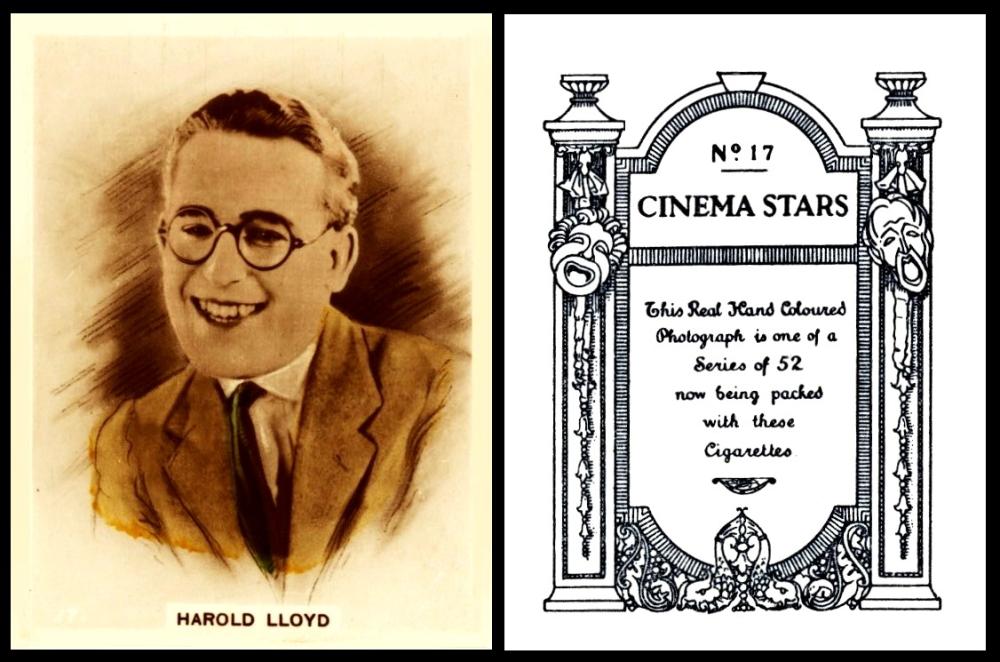
Anonymous [tobacco : O/S] "Cinema Stars" (1925) 17/52 - ZA08-210 : ZA8-12 : RB.21/236.1A
ONE HUNDRED YEARS AGO TODAY - APRIL 1st 1923 - The premiere of the film "Safety Last", starring Harold Lloyd, took place. The stars were Harold Llloyd, showing on our card, and Mildred Davis, his new wife - they had married in February of the same year - though they had been acting partners since 1919, when he was split up from his on-screen partnership with Bebe Daniels.
If you never saw this film, you will have seen the most famous scene, of Harold Lloyd hanging far above the streets from a giant clock, the front of which has become loose, and is threatening to tumble, with him, to those streets below. In the film Harold Lloyd played a character called Harold, and Mildred Davis plays his girlfriend. After a lot of chaos and confusion he hits on yet another way to raise money, by climbing a skyscraper, which was a bit of a craze in the 1920s. But in the end it all works out okay and the hero is reunited with his girl.
Harold Clayton Lloyd was born in Nebraska in 1893, and his first film appearance was in 1913, when he played a Native American. His name did not appear on screen. In 1915 he was cast as Lonesome Luke and this went on to be a bit of a series, over sixty short films, ending in 1917 with "Lonesome Luke`s Lovely Rifle". W.D. & H.O. Wills "Famous Film Stars" 70/100 tells us that he was Lonesome Luke for just over two years, which gives you a good idea of his workload. He then went back to other assorted shorts, but increasingly played characters called Harold, slowly ingraining his real name with the audience, who would become his fans.
It looks like his first appearance on a card in the United Kingdom was in the set of "Famous Heroes" issued by Boys Magazine in 1922. His first time on a cigarette card was on those lovely circular "Cinema Stars" issued by Godfrey Phillips in 1924, which mentions "Safety Last", and this is backed up by the text which states that "...it is only during the last two years that he has become so well known". However according to TheTradingCardDatabase/HaroldLloyd he did appear on American cards earlier than this, and the Kromo-Gravure card they start with is very similar to a 1919 postcard that names him "Winkle (Harold Lloyd)", one of his film aliases.
Strangely many of the cards of him have either plain backs or designs, not biographies. Nicholas Sarony`s "Cinema Stars" 13/50 is good though, and tells us that he was "born in Burchard, Nebraska", that his "first job was with Hal Roach", and even gives us statistics - that he was "five foot ten and a half inches tall with brown hair and blue eyes". This is continued by Abdulla "Cinema Stars" 17/32, which says he "came from the screen from the stage, where he began work as a boy, and made his first start as an extra. He later won fame with his comedy creation of Winkle, but later discarded this make up for his well known spectacles and used his own name."
He remained in front of the camera until 1947, and his final film was "The Sin of Harold Diddlebock". It was shortened and re-released in 1950 as "Mad Wednesday". However it was actually a follow on from another Harold Lloyd film, called "The Freshman" in which his character would do anything to get a laugh, and more popularity, at his college. And the same football game is featured in both films, for in the 1923 version he scores the winning touchdown and gets the girl, and in the 1947 one it is revealed that he also received a job offer, from an advertising firm that he is just being forced to leave after just over twenty years employment.
After he retired from the screen he worked on radio and was on many talk shows. He also made compilation films of his greatest moments and stunts, which kept his name before the public, but seldom featured the more sensitive moments from them.
He was married to his wife until her death in August 1969. He died in March 1971. Oddly Bebe Daniels only outlived him by eight days, and his only son, Harold Lloyd Junior, an actor and singer, died three months after, aged just forty. His two daughters lived on for longer, Mildred Gloria Lloyd died in 2012 and Marjorie Elizabeth "Peggy" Lloyd died in 1986.
This set is usually known as "Cinema Stars Set 4" and though it is anonymous it was issued through British American Tobacco. The cards are hand coloured on top of a brown image, and they measure 63 x 48 m/m, so are classed as medium size. However you can also find the same pictures, still in the medium size, with a slightly different back, and a maker, Westminster Tobacco, as well as a different title "Film Favourites" - and they are also available both in a handcoloured version, like ours, or in the natural brown tones.
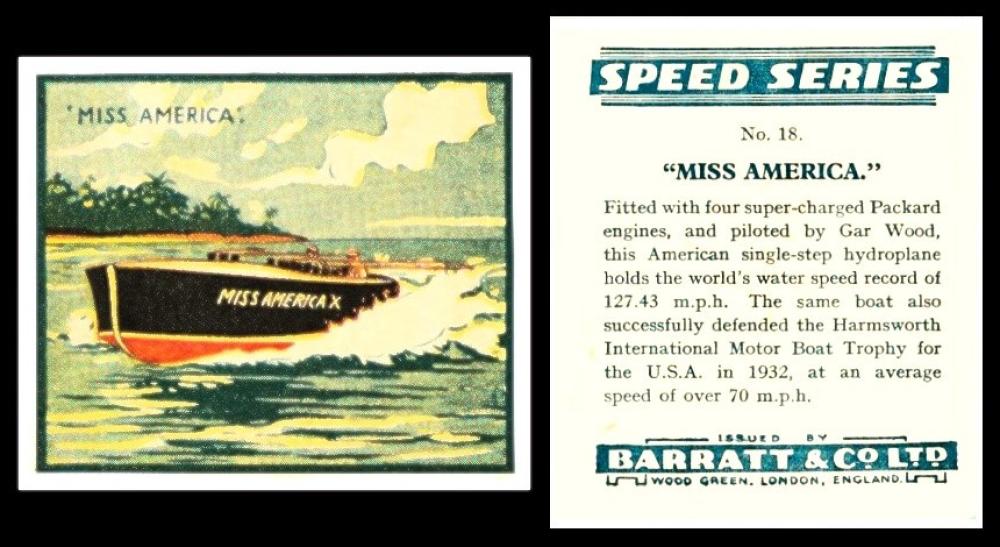
Barratt [trade : confectionery : UK] "Speed Series" (1930) 18/20 - BAR-300
If you had a time machine, and set it for today in 1960, you could visit one of the forerunners of the Grand Cartophilic Convention, at a time when they were simply an Annual General Meeting, followed by an auction, sometimes, and this year there was. Actually this 1960 event was the earliest date in the year that it has ever been held, so we are celebrating it here, and adding lots more facts to the Convention Archive.
So this year`s event is at https://csgb.co.uk/events/convention/1960
The same magazine included a report on the auction, written by W. M. Wright. This says that :
THE BUSINESS of the Annual General Meeting held on April 2nd will have been reported elsewhere in this issue, but following the formal business , we had an auction of some 46 "Lots". Mr. E. C. Prior very kindly gave his time and skill to us in wielding the gavel, Mr. Piper and Mr. Knight helped by displaying the items, and the balancing and clerical worjk was ably attended to by Mr. Pitts.
The items offered were varied, but there were no outstanding rare items. Top price realised was .£5 for a number of the Society`s Reference Books, and £3 4s. 0d was paid for a set of Felix Potin`s "Flowers, Plants and Fruits" (84 in set). A box of 128 different periodical specimen cards made £1 16s. 0d., whilst a set of "Speed" by Barratt (a set of 20 and quite scarce complete) fetched £1. A few rare types were on offer and made £4 for the eight.
Some lovely postcards (in albums) of the Trade variety were put up , but failed to reach the reserves placed upon them . A set of 12 Suchard cards "Gullivers Travels" commanded 21/- whilst 12 type cards of Suchard made 20/-. A small parcel of Maltese (Cousis) Celebrities was broken down into 8 lots and made 42/-. Total realisation for the 46 lots was £38 2s 0d and a commission amount of £16 0s 8d goes to the Society. Expenses were NIL.
And that explains why we have the card for today that we do!
Now it does not appear that the auction list was printed in the magazine though I might come across it on another journey. So was it loosely inserted, in which case does anyone have a copy that they could scan so that it might be included and retained for all time? If you do, many thanks
This set does not seem to appear in our original British Trade Index, unless you can track it down. However the modern update has it as being issued in 1930, a set of twenty, and measuring 72 x 60 m/m. I have not yet been able to find the other subjects, but will have a better look over the weekend.
Several boats driven by Gar Wood were called Miss America. His first was taken to England in 1920 to fight for the Harmsworth Trophy, and he won, the first of eight of them he would win in his lifetime. You can see Miss America VIII on Ogden's "Yachts & Motor Boats" (1930 : 25/50) and Miss America X is mentioned on Ogden`s "Champions of 1936" (1937 : 38/50) though the front is a close up of Gar Wood, not the boat.
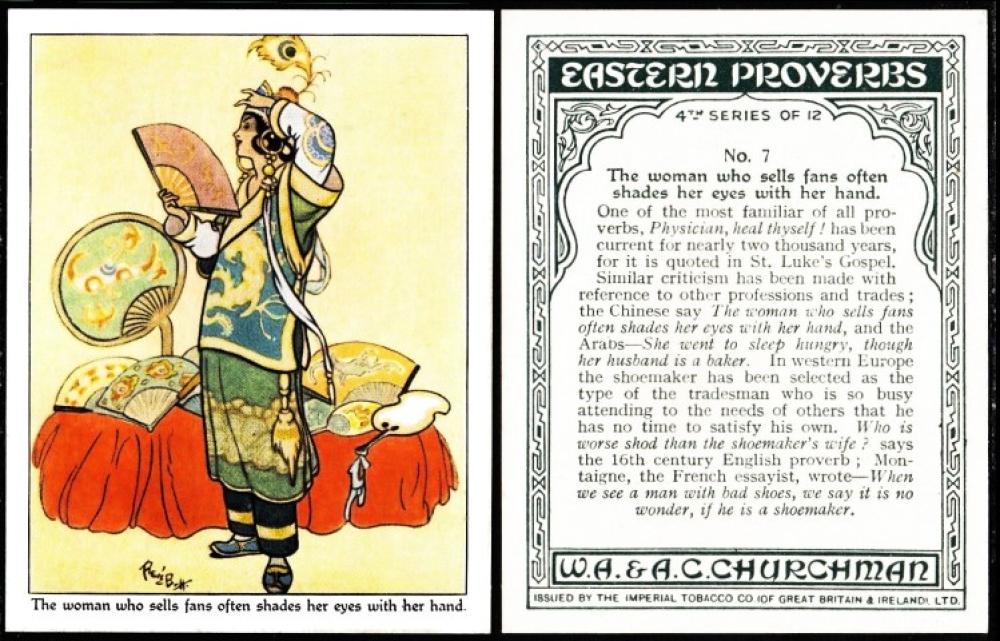
W.A. & A.C. Churchman [tobacco : UK] "Eastern Proverbs" large, fourth series (1934) 7/12 - C504-470.4 : C82-44.4 : H.521
Today is actually Fan Dance day, which is a great time to discuss these interesting and expressive items. The day is intended to celebrate the art of the Japanese Fan Dance, which is centuries old, and developed from what was simply the way to keep cool into a way of entertainment and pleasure. However at its beginning it was purely for the rich and famous, which is possibly how it gained its allure. The art of the fan is to conceal, and that was never so explored as in the theatre, where a fan was often used to cover the entire body as part of a dance. And it was used to great effect at the Windmill Theatre, amongst others, to cover the naked form, which could just be glimpsed behind as the fans shimmered around in the hands of the user
Fans are made from all materials, and they feature on several sets of cigarette cards, either as one of the set, like Kinney`s "Novelties", or as the whole subject, as in Allen & Ginter`s "Fans of the Period" - and the card that links whisks you to is a very Japanese style fan, it even has a fish, perhaps even the Emperor`s koi carp on it. Strangely both these cards were issued in 1889.
Churchman seemed to like our set, and they issued it in several versions starting with "A Series" if twelve cards in large size in January 1931. This was then followed by a standard sized set of twenty-five cards in August 1931 and a second series of twenty-five in August 1932. Then there were three more series, each of twelve large sized cards, the second and third series both in 1933, and the fourth, ours, in 1934.
I would be interested to hear which cards do not appear in the Churchman large sets, because four twelves are forty-eight and the two standard sized sets make fifty.
Ardath also issued a standard sized set, of twenty-five cards, in New Zealand. I have not had time to find out much about this, but the top borders to the fronts are blank, and though they use the same Eastern archway to the top of the reverses, the bottom panel is larger. They were issued with 'Cork Tipped' and 'State Express 333' cigarettes.
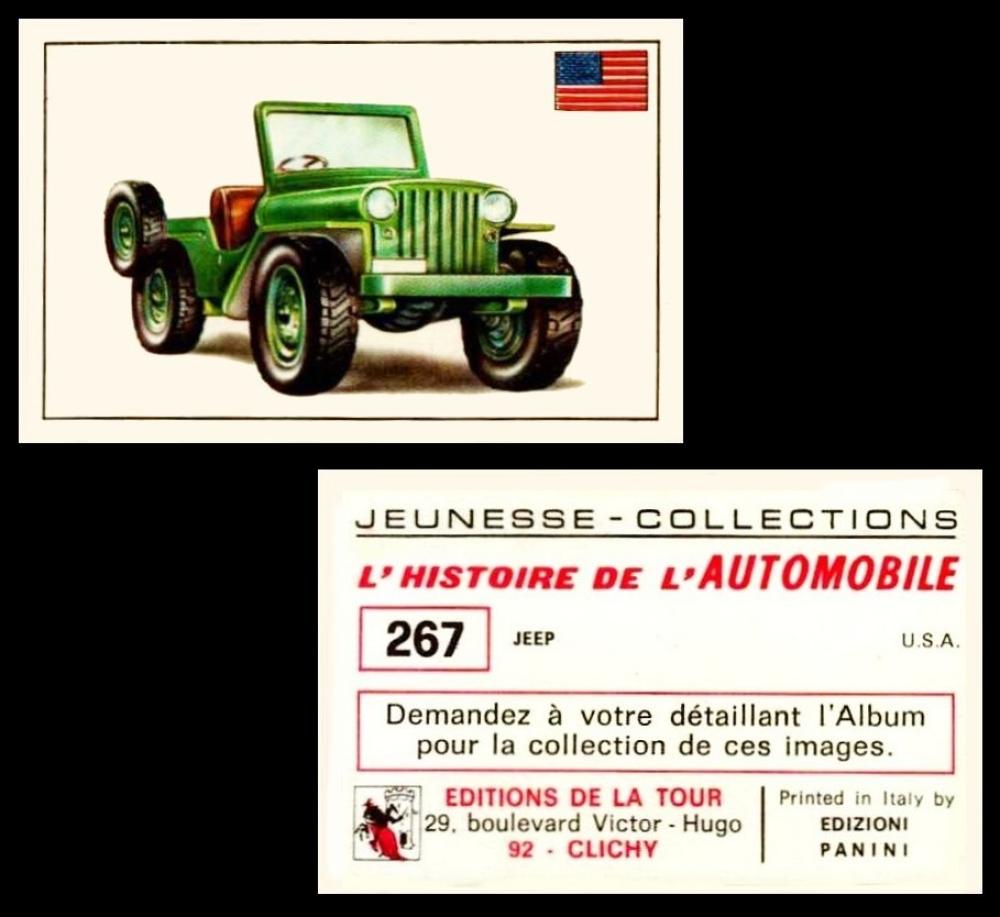
Panini [trade/commercial : O/S : Italy] "L`Histoire de :`Automobile" (1972) 267/?
Today is Jeep 4 x 4 Day and here we have a Jeep. Now there are lots of theories about how the Jeep got its name - some say it means G.P. or general purpose, referring to its go anywhere do anything nature. But in the military, before these vehicles were even invented, a Jeep was a any new vehicle, or raw recruit, something untested in the field of battle. So that fits too.
The first American Jeep was built in 1941, and it saw service all over World War Two, facing jungles and mud and desert with equal ease. The first civilian version was made by Willys in 1945, though they also made the military ones for longer, I owned one that had been brought back from Vietnam. And they also made them as beach buggies, with pink paintwork and striped canvas tilts. If you look at ones like mine, which was an M38-A1, and compare them with the modern Jeep Wrangler, first made in the 1980s, you will see there is little difference, apart from the fact my windscreen wipers were hand operated, and you no longer get a rifle rack. I loved that Jeep, but sadly it caught fire whilst I was driving along, and that was the end of it. Wouldn`t rule out getting another though....
Our set, and they were stickers, included cars of all ages, their mechanical parts, manufacturers, marques and badges, including some clubs and tyre manufacturers, motor racing circuits, famous drivers, and some really great images of early posters.
It was issued in France in 1972, but was issued in Italy a year earlier. I have only so far found it in the French and the Italian language - but you may know of more.
Some sellers seem to think that Jeunesse-Collections was the issuer, but "Jeunesse" is French for youth, so these were just sold as collections for young people
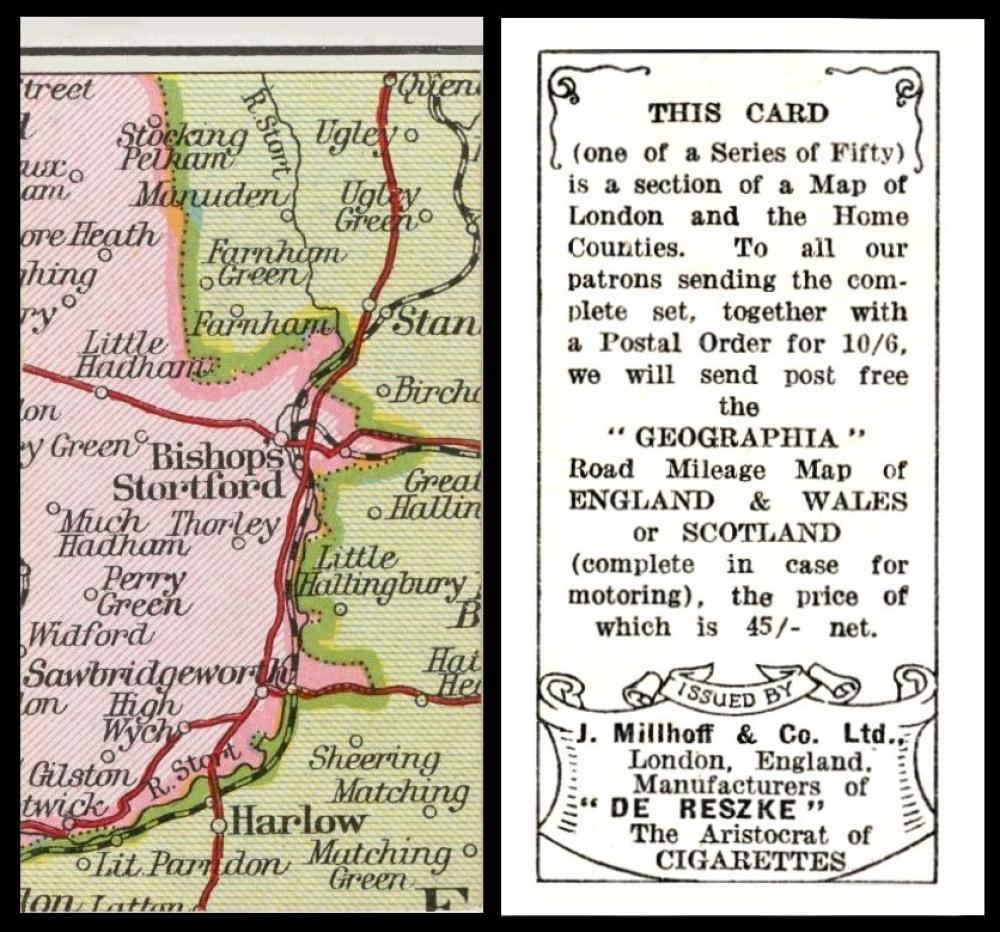
Millhoff [tobacco : UK] "Geographia Map Series" (1931) Un/50 - M699-200 : M108-17 : RB.113/333
In honour of National Read a Map Day, which is today, here is a map. Now I wonder how many of you also get pleasure from spreading a map on the floor and tracing the course of a river, or hunting for local footpaths and byways to explore? I love maps, and they are definitely an equal substitute for actually going places. In lockdown, they kept us sane, and I will always be indebted.
Now the first thing that strikes me is that this set was almost certainly not intended to be called what it ended up being. Those early cartophilic cataloguers simply hit on the fact that when you had got all fifty cards you sent them all in with a postal order for 10/6 and you got sent a Geographia Map in exchange, a map that you could lay on the floor with and not worry that the dog would run through scattering all those carefully abutted sections hither and yon.
Personally I think the name ought to have been "A Map of London and The Home Counties", as it says at the top. But when it appears in our original World Tobacco Issues Index there is not a sign of doubt, not even an (A) to show the title was adopted.
There is a curious thing, because in that original World Tobacco Issues Index it mentions the fact that you sent the set and 10/6 and exchanged it for the road map in the case. But by the time of the updated World Tobacco Issues Index, it simply says you sent the set and "cash" without giving the amount. I do not have an RB.113, it is the updated Godfrey Phillips Reference Book, I do have the original, but this set is not mentioned in it. Maybe someone who does own it could kindly provide us with the listing in that to see whether the 10/6 was restored?
By the way the different colours on this map is a usual practise to easily show the places where one county changes to another.
Geographia was founded in 1910 by Alexander Gross, a Hungarian who had moved to London. Then in 1939 he moved to New York and started making maps of America. Some say that he moved to get away from memories of war, which sounds likely as the clouds were gathering, and England was nearer to Germany than he felt safe being. Whilst others say that he had run into financial difficulties, but he must have had the money to relocate to America and also to almost immediately set up business, because maps exist of New York that are dated 1939.
Strangely his daughter set up a kind of rival company, the A to Z, in the mid 1930s.
Anyway as I plumped for this section out of all, how many of our readers live within its bounds? If you do, tell us. You do not need to state the town, just that you are within the area. Looking forward to hearing from you.
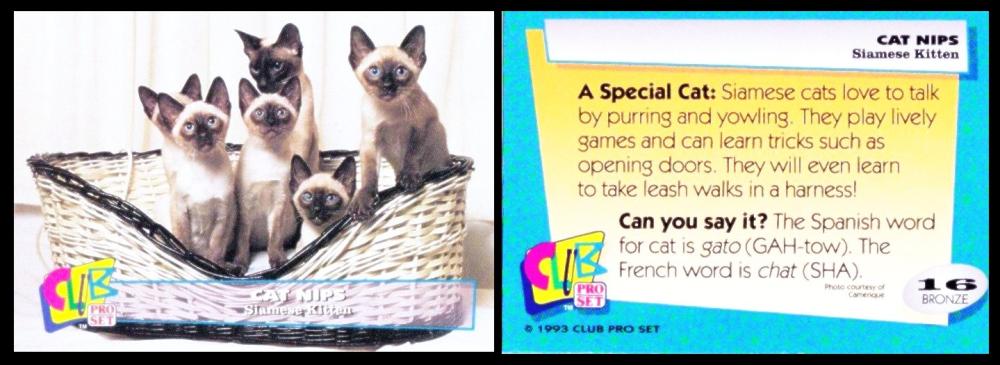
Club Pro Set [commercial : educational] "Cat Nips" second series (1993) 16/18
For Siamese Cat Day we have a basket of kittens. The Siamese cat has very distinctive features with brown circular colouring round the centres of their rather triangular faces, and their ears are also brown. They are also very regal. However when they were first seen in America they were viewed as a novelty that would not take off, and they were also thought to be the freakish result of a nightmare, with blue eyes that followed your every move. They only really took off because of a gift, when a Siamese Diplomat sent one to the wife of President Rutherford B. Hayes in 1879, and suddenly they were much sought after, though this poor feline did not last very long, the two month trip from their home country had proved too much for them.
In their native land they are revered, for there is a belief that they are reincarnations of lost loves, or lost family members. The sounds they make are quite unlike other cats, and that is seen as the old soul trying to communicate. They also become very attached to their owners.
Another cartophilic Siamese can be found amongst John Player`s "Cats", as card 14/24. The text tells us that they do need a little more care than other cats, and are noisier, but they are very popular, and that there are now probably more of these companionable cats kept than of any other. They also mention the shape of their heads, but call it "long and wedge shaped, any tendency to roundness being a serious fault from an exhibition point of view".
You will also find one on Horniman`s Tea "Pets" as card 5/48. This also mentions its closeness and delight in human companionship, but it says it is very noisy at times, especially when it is on its own. And it closes with an entirely new fact, that the kittens are born white.
This set was issued in America in three formats, a Bronze, a Silver, and Gold. There was also a first set of nine cards, so we have taken the liberty of counting the two together because it is just too confusing to have card 16/9. You can read all about the set at Jeff Allenders House of Checklists and that contains a link to the Club Pro Set blog, where even more information can be gleaned, about this set and all the other sets they issued, including sports cards.

Cavanders Ltd [tobacco : UK] "Wordsworth`s Country" (1926) 16/30 - C230-580
Today, Good Friday, is also the birthday of William Wordsworth
He was born in Cockermouth, part of the Lake District, and went to Hawkshead Grammar School between 1779 and 1787, the school is worth a visit for he scratched his name into his desk when he was but a child, and it is still there.
Nicolas Sarony`s "Celebrities and their Autographs" tells us that after leaving Hawkshead he attended Cambridge, and that "in 1791 his sympathies with the Revolution led to his taking up his residence in France, but later he took opposite views". There is a bit more story to this, for he only went to France as a visitor, in November 1791, and was overwhelmed with the story of the Republicans. He also fell in love with a local woman, and she gave him a daughter the following year. However even before he saw his daughter, he left, having fallen out of love with France and with the actuality of the Revolution.
The Sarony card picks up with the fact that "He settled in Grasmere, 1799, and married Mary Hutchinson, 1802" And in 1802, just before this marriage, he went to see his daughter for the first time and they spent some time together. In fact his wife made William send some money, and to send more on the occasion of his daughter`s marriage in 1816.
Sarony tells us that "In 1813 he went to live at Rydal Mount, where he spent the rest of his days". That was a lot of days, for thirty years would pass before he was made Poet Laureate, and he did not die until April 1850.
This set is unusual, for it uses his name and shows some of the scenery that inspired him, though he does not appear to have ever written about this place, Skelwith Force, on the Brathay River. However he would certainly have known of it, for though it is not a large fall only sixteen foot drop, it is most spectacular after a rainy day.
It is also not listed in our original World Tobacco Issues Index, hence the single code from our modern version. That tells us the cards are medium size, numbered, and a set of thirty cards.
This week's Cards of the Day...
Welcome to Monday - and the solution to our latest week`s theme, which is simply the fast approaching month of April. Indeed when I lie me down to sleep, after having made my final embroidery to this worthy edition, and pressed the send button, April will be already here
So why, you may be asking, is this month called April. And there is much discussion. Most people think it comes from the Latin "aperire" which means "to open", and it was named for the fact that even when the Romans roamed they noticed that the months before were cold and the trees bare, or with their buds tightly protected against the weather`s incursion, then all of a sudden all the leaves and the blooms unfurled of themselves. So they called this month Aprilis. At that time, of course, it was the second month of the new year, March being the first, and before that the conjoined time called simply Winter (if you were polite). The changes, the adding of January and February, put April fourth, and there was also a change in the number of days, to twenty nine. Well they had to fit January and February in somehow! This was about 450 BC. And there were twenty-nine days right until 1582, when Pope Gregory immortalised himself with the Gregorian calendar and gave April thirty days.
However if you think that it is odd that it this month is not named after a God or Goddess, you might be tapping into the truth - for Aphrilis was one of the names for the Greek Goddess of Love Aphrodite. Did the Romans hear this and think it was Aprilis not Aphrilis, or was there simply a scribing error? After all if you look at the calendar, or at least the first half up to June, four of them are named after Gods and Goddesses. The other one, February, is sometimes said to be named after a festival of fire, but that was dedicated to a God called Februus, though he was later usurped as the God in charge by Vesta, the Goddess of fire, and it seems that after this people started to forgot poor Februus and even eventually denied him his month. But if we give it back to him, the only month left is April. So maybe that WAS intended to be Aphrodite`s after all.....
Saturday, 25th March 2023
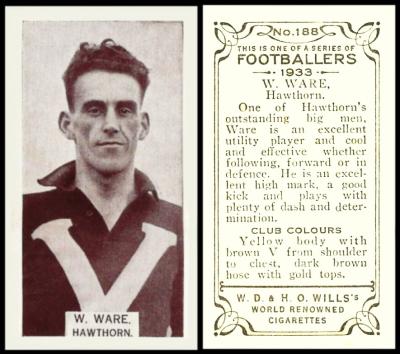
A bit of a change to this week`s Saturday Soccer Star as we have gone "down under". The clue here was the team, Hawthorn. Now some of our older readers may remember that hawthorn flowered in May, but owing to climate change it is now considered to bloom in April, and has become that month`s flower. It has lovely white, or sometimes pink flowers, and its berries, or haws, provide winter food for birds, as well as give them shelter, for if they fly inside the body of the hawthorn those thorns will stop most predators going further.
You will not find many growing in gardens though because they do have a particular aroma that some humans find offensive. However like all nature it has an important function, for the pollen is spread by flies, who really like that kind of smell.
The best write up on this set appears in our original Wills Reference Booklets :
Fronts printed by letterpress, unicoloured in brown. Backs in grey-black with descriptive text, inscribed at base "W.D. & H.O. Wills`s World Renowned Cigarettes". Issued in Australia 1933.
A) small cards size 67 x 37 m/m
B) medium cards 66 x 52 m/m. Two grades of board
a) white b) cream
Our man, W. Ware was better known as Wally Ware, though he was born Walter Leslie Ware, this month, 19th the town of his birth, but his main team was Hawthorn, part of the Victorian Football League, where he played between 1930 and 1934. You can read more about him at AustralianFootball/W.Ware - where they also mention the fact that his younger brother, Norman, was also a keen footballer, some say better than Wally, and he played, and coached, at Footscray.
And that was the teaser clue we gave you, for Norman also appears in our set, in his Footscray strip, as card 78, plus, according to TheTradingCardDatabase/NormanWare on eleven other cards. However the Trading Card Database calls these cards "1933 Victorian Footballers", I know that refers to the state and not the time frame but I wonder if any readers have heard this set called that before.
Norman`s card also mentions The Brownlow Medal" - which is more correctly known as The Charles Brownlow Trophy, or even, rather disrespectfully, considering it is awarded to the "best and fairest" player, as The Charlie - and yiu can read more about that at Wikipedia/BrownlowMedal
Sunday, 26th March 2023
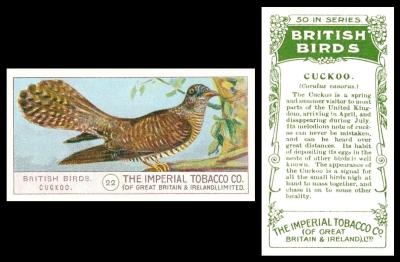
So your clue here was the bird, the cuckoo, which to many people is the real sign that Spring has sprung. And the first time you hear that unmistakeable sound is usually in mid April. Strangely this has not become earlier like the hawthorn, because traditionally it starts singing in the south of England on St. Tiburtius`s Day, which is the fourteenth of April, and it slowly moves up to the north of England until its song falls silent in June. However I have not been able to find a link between the cuckoo and the saint. So if anyone knows it do let us know.
Our original World Tobacco Issues Index says that this company was "founded 1901. Combination of various firms, see RB.7 and RB.18. Trading 1956. Almost all cards bear the name of the Branch and are listed thereunder. The two issues below bear the name of the firm only and were issued in 1902."
Our set comes first - "I/4-1 British Birds. Sm. 67 x 35. Nd. (50) See H.229". Set I/4-2 is a folding card to celebrate the Coronation of His Majesty Edward VII and Queen Alexandra, this measures 70 x 40 closed, and the centre shows portraits of the two Royals.
Most of this information is repeated in the updated version of our World Tobacco Issued Index; the only changes relate to the fact that there had been another set issued under this name. That means the reference to there being "two issues below", and the fact that the cards "were issued in 1902" were both deleted. The extra set was issued in 1993, and the cards were untitled but it was given the name of "Russ Abbot`s Advertisements"; they were of medium size, measuring 80 x 47 m/m and there were twelve cards in the set.

H.229 is our handbook. This lists our set as
British Birds (titled series) Fronts in colour. Numbered series of 50. pre-1919.
Imperial Tobacco Company Ltd. Ogdens Ltd.
A) white back
B) Toned back.
The Ogdens version was actually issued in 1905.
But here is a comparison scan between the two backs, which proves that the only difference between the two sets was the text in the bottom box..
The other two books quoted in the text above, RB`s 7 and 18, do not mention our set but are to do with the issuer. RB.7 is our Directory of British Issues. That lists all the companies which were part of The Imperial Tobacco Company (of Great Britain & Ireland) Ltd. However some of them did not join until later, so the scan which follows is from RB.18, the Tobacco War Booklet, and that is much easier to follow - as well as interestingly showing the amounts that the I.T.C. paid for each of those original companies
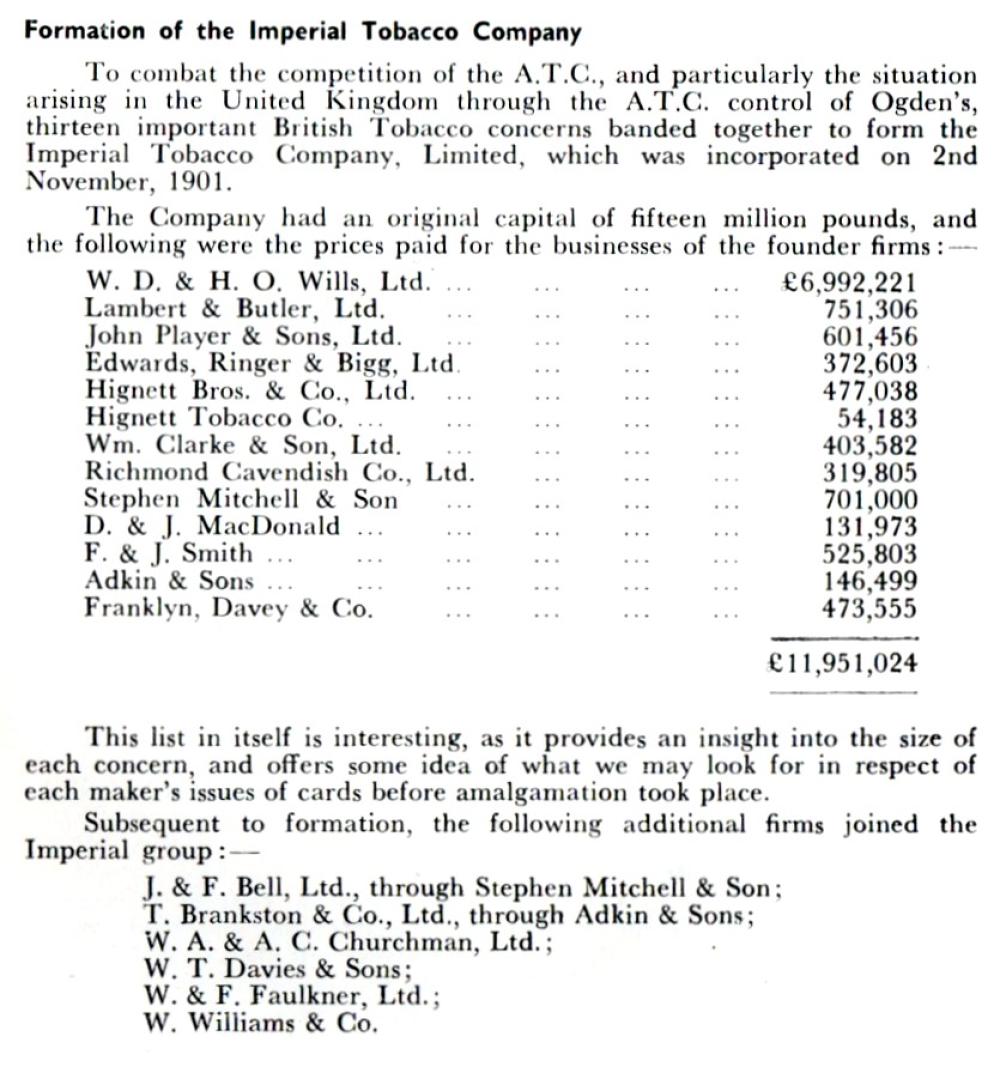
It also states that as well as the Tobacco War Booklet and the British American Tobacco Company Booklet, there was intended to be a third, "The Imperial Tobacco Company Booklet". But this book was never issued.
Monday, 27th March 2023

I am certain I have used this set before, because it is one of my favourites, but cannot find it. Anyway we are showing it as an illustration of "April Showers" - as in "Though April showers may come your way, They bring the flowers that bloom in May". This song was unbelievably first sung in 1921, by Al Jolson, in a Broadway musical called "Bombo" that also included the songs "Toot Toot Tootsie Goodbye" and "California Here I Come". And Al Jolson was also the first to sing it on screen, five years later, in a film called "A Plantation Act" which runs for just ten minutes and includes three songs!
This set appears in our British Trade Index book three, where it tells us it measures 76 x 77 m/m and is a set of twelve cards. There is also a link to Db.455, which is at the back of the book where all the alike series are issued, and that tells us that the set was also issued by Lyons and by Tonibell. Lyons might confuse you because they had fingers in many pies but looking at the actual cards you will quickly see they say Lyons Maid so they were issued with ice cream, as was the Tonibell set, and ours.
Tuesday, 28th March 2023
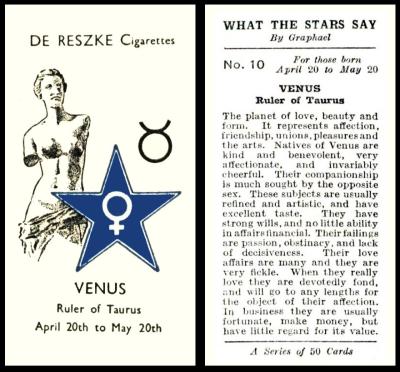
So lets start with those codes for this is curious cartophily indeed.
In our original World Tobacco Issues Index this set gets a "P" code and is listed under Godfrey Phillips. But it is not in our original RB.13 devoted to the issues of Godfrey Phillips, nor in our updated World Tobacco Issues Index.
Eventually I find it in the Murray Catalogue of Values listed under Millhoff, and find it in our updated World Tobacco Issues Index there too.
I know that Godfrey Phillips owned Millhoff but can anyone shed a little light on this issue?
And I have seen it listed under D for DeReszke, but that was just the brand - which was named after Jean De Reszke, a Polish opera singer. He had been advised to stop smoking cigars, which he much enjoyed, as they affected his voice, so he had moved over to cigarettes, with only varying success. Then somehow he came in contact with Jacob Millhoff, a Russian cigarette manufacturer, and opera fan, who worked on a tobacco that would be a smoother smoke and not play havoc with the great man`s voice. Reportedly DeReszke was so pleased that he agreed to let Millhoff market the cigarettes under his name, and to appear in the advertising. DeReszke died of bronchial influenza in 1925, almost a decade before these cards were issued. But the company was still, dare I say, cashing in on him by using his name.
The title is also a little odd, for in 1934 a lot of people would have thought of "stars" of the screen, but this is all to do with astrology and the zodiac. It is very well researched as well and even gives the lucky colours, numbers stones, and days.
Venus, showing here, is depicted as Venus de Milo. She also appears on another card, number 30, in the same set. Why she is here this week is that she was the Goddess of fertility, and her sacred month was April, when flowers and trees sprang into bloom, and prepared themselves to make fruit.
Wednesday, 29th March 2023
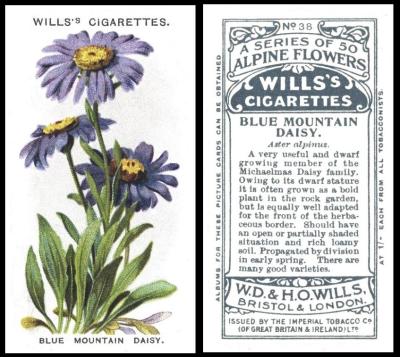
Now we have taken a bit of a liberty here by using an Alpine daisy, but the daisy is the birth flower for the month of April. The flower is named after its curious habit of closing its eyes at the end of the day and going to sleep - in less romantic terms, the flower closes up once it starts to get dark and cold. However this blue Alpine version, Aster Alpinus, still does the same,
So this set first appears in our original Wills Reference Book part 3, where it is coded as W/36 and described as : "50 Alpine Flowers. Fronts lithographed in colour, backs in grey with descriptive text. Home issue 1913." The month of October appears only when the five books were reprinted and published as a hardback. They come from listings in the Wills Works Magazine, which they kindly shared with us.
In our original World Tobacco Issues Index this has the rather interesting code of W62-62. But all it says is "Sm. Nd. (50)". This scant breadcrumb also appears in our modern World Tobacco Issues Index but curiously this set is not actually coded in that volume - however it is sited between Allied Army Leaders W675-092 and Arms of Companies W675-096, so I have taken the liberty of taking the middle path and giving it W675-094.
Thursday, 30th March 2023
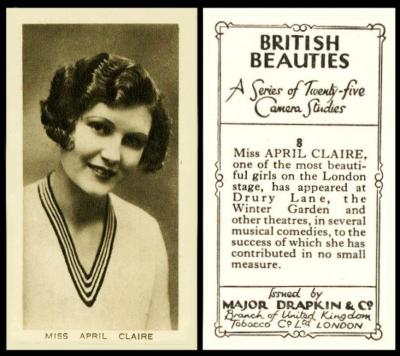
Today we celebrate the fact that April is not just a month, but a name, and especially popular for girls born in that month. And despite some people thinking it is an old fashioned name, it is still being used in fiction and on film.
An unusual set because it was an export issue only. And our World Tobacco Issues Indexes both tell us just that it was "Sm. Brown Gravures, Bd. (25) Export."
Our subject, Miss April Claire, is also unusual, for I cannot find her, all I know is on this card, that she appeared at Drury Lane and the Winter Garden. The other ladies are, for the most part, unknown to me as well, though several of them seem to be models and even mannequins, which was the term then for a catwalk style of model - but maybe you can flesh them out a little more. I do know that card 10. Miss Ivy Close was a film star in the silent era, though she got there by winning a contest, and that card 16, Miss Miriam Sabbage was in another contest, run by the Daily Mirror, where she was voted the most beautiful woman war worker - though it only calls it "a big beauty competition" on the card. I also have a suspicion that card 11. Miss Ursula Morton is actually Miss Ursula Moreton - encouraged by the fact that the card mentions dancing, and the Russian Ballet.
As the set is hard to come by, and also to make it easier for me to hunt them, here is a list of everyone in it :
1. Miss Elsie Cadman - 2. Miss Edith Ashley - 3. Miss Margery Hall - 4. Miss Heather Tracy - 5. Miss Molly Malone - 6. Miss Doreen Crosley - 7. Miss Gabrielle Gilmore - 8. Miss April Claire - 9. Miss Rene Clama - 10. Miss Ivy Close - 11. Miss Ursula Morton - 12. Miss Joyce Barbour - 13. Miss Gordon - 14. Miss Maureen Shaw - 15. Miss Winifred Davey - 16. Miss Miriam Sabbage - 17. Miss Bernardine Wallace - 18. Miss Nancy Rigg - 19. Miss Stephanie Stephens - 20. Miss Stella Pierres - 21. Miss Thelma Bayly - 22. Miss Mary Mullen - 23. Miss Kendall Storey - 24. Miss Joyce Williams - 25. Miss Mamie Whittaker.
Friday, 31st March 2023
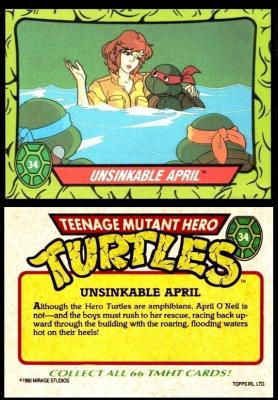
Remember what we said about despite some people thinking April is an old fashioned name, it is still being used in fiction and on film. Well here we have April O`Neill, who when she made her first appearance in a comic book, in 1984, was just a computer programmer . However she ended up being the first human to really understand the Teenage Mutant Ninja Turtles after they saved her life when she was being attacked by robots. And then she left her job, and opened an antique shop, which the Turtles would eventually cause to be destroyed. But she still brought them pizza. After that her life got pretty complex, she fell in love with a guy who turned out to be a vigilante, and eventually they would get married and she would help him raise his late wife`s daughter, though she would also do a bit of vigilante-ism and in 1994 she was turned into a turtle. She also got a new career as a newsreader, and she changed her hair colour from a really interesting coppery red to an even more interesting magenta-purple, then went back to just a brownish brown.
The original big screen film seems to have amalgamated all of this, though she is always a news reporter and she still gets an antique shop which the Turtles manage to get destroyed. The cards show her as a news reporter from the start.
In fact there was more than one film, six in all, starting in 1990, and more than one trading card set.
TheTradingCardDatabase/TMNT lists twenty-five different sets, by issuers Diamond, Fleer, Hostess, McCains, O-Pee-Chee, Regina and Topps. Our set was the first and shows her in cartoon form. There were eighty-eight cards and eleven stickers, but there were also four packet designs in yellow or red, showing each of the turtles, Donatello, Leonardo, Michaelangelo, and Raphael. There was also a second series, in which the numbers carried on to make a total of 176 cards. Most people seem to consider the first set is just half the set.
The early items are easy to tell because the British versions call the foursome Teenage Mutant HERO Turtles whereas in America they kept the original comic book title of Teenage Mutant Ninja Turtles.
Well, dear readers, I must close. I will fill in the missing code tomorrow, it is only the Geographia Map, and if that turns up any more cartophilic information I will add that too.
Have a happy weekend, and dont forget to come back next week for another instalment
